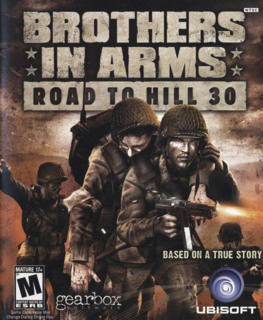While a competent shooter, Road to Hill 30 doesn't have the impact it could have had.
Beneath the greenish cloak of World War 2 familiarity, however, hides an unusually innovative game that, to a large extent, successfully manages to blend fast-paced FPS action with tactical combat. During Road to Hill 30's 7-hour campaign, you'll have at your disposal several squads of soldiers and on occasions even tanks. The best part is that commanding your squad around is, for the most part, surprisingly simple, so gamers with an aversion towards micromanagement needn't be worried that the tactical elements of this game interfere with the flow of the game too much.
The squad commands are issued from first person, and are limited to such basic actions as setting waypoints, engaging, following and taking cover. This rather elemental approach may leave the more serious tactical shooting enthusiasts craving for more depth, but it does succeed in finding a rather steady balance between the rapidness of more arcade-styled first person shooters and the cooperation-based gameplay of tactical shooters, without scaring away fans of the former with too much complexity in the latter department.
But while the implementation of squad tactics is impressive, it is not without problems. The first gripe is that there is only really one tactic to get through the game: have your squad mates suppress the enemy as you flank and kill them. Occasionally, when you have a tank at your disposal, you can send it ahead to kill everyone, but this doesn't really put your capabilities of decision-making to the test either. There were some more interesting sequences, such as a level near the end where you have to take out two tanks and clear out a warehouse full of Wehrmacht soldiers, but these moments were scarce among the huge amount of combat situations where you just had to crouch from cover to cover in order to get a clear shot of your foes. The mid-section of the game in particular is ridden with these sequences, making many of the missions in this phase of the campaign a drag more than anything.
An even bigger problem is the hit detection. In this game, both your allies and enemies spend a considerable amount of time sitting in cover behind hedges and muddy walls. Problem is, the game is very generous in terms of when it considers the AI to be in cover. It occurred multiple times that I fired several rounds at an enemy at point blank range, and the hits wouldn't register because the lucky bugger was still behind cover according to the game, effectively making this the first shooter I've played that has dynamic invisible walls. Contrarily, enemy shots will often hit you even though you are sitting behind a wall. Furthermore, with its heavy focus on cover-based combat, the absence of prone/lean capabilities can be rather annoying at times.
Fortunately, the gunplay is very well done. Weapons feel authentic, with slow reloading times, relatively low firing rates and noticeable recoil making for the clunky, heavy feel you would expect from WW2-era weaponry. As in real life, your character's hands aren't completely steady as you aim down the iron sights, while the inaccuracy of the antiquated weapons makes it even more difficult to engage your targets over greater distances. All of this makes for an authentic feel that is, once again, a welcome contrast with the pure arcade feel of your usual WW2-themed shooter.
The narrative in Brothers in Arms is worth a mention, as well. The story is told as a flashback by Sergeant Matt Baker, who gives his account of the operations in France following D-Day, in which he and his team must secure a French town and make the push to the titular Hill 30. During the game, you'll encounter various colourful characters that will seem familiar from WW2-themed cinema such as Saving Private Ryan and Band of Brothers. As you get further into the campaign, more of your squad members will perish, making for plenty of emotional moments that are even more convincing due to the great voice acting. The only thing that drags the experience down (if only a bit) is the fact that your squad members may die in combat during the missions themselves, but they'll be revived automatically for the next mission. This makes it somewhat hard to bind with the characters during the game itself, restricting the emotional moments to scripted cutscenes outside of gameplay.
With everything taken into account Brothers in Arms is a very decent first person shooter that has fair amounts of both innovation and polish. Despite its flaws, it blends the arcade and tactical shooter genres rather competently, making for a refreshing experience in an otherwise worn-out setting. It's just too bad that some parts of the campaign give the impression of proof-of-concept rather than inspired game design, because a 7-hour campaign can't afford too many dull moments. And while its campaign is by all means worthwhile, Brothers in Arms: Road to Hill 30 has too many of those for the game to make the impact it could have had.

